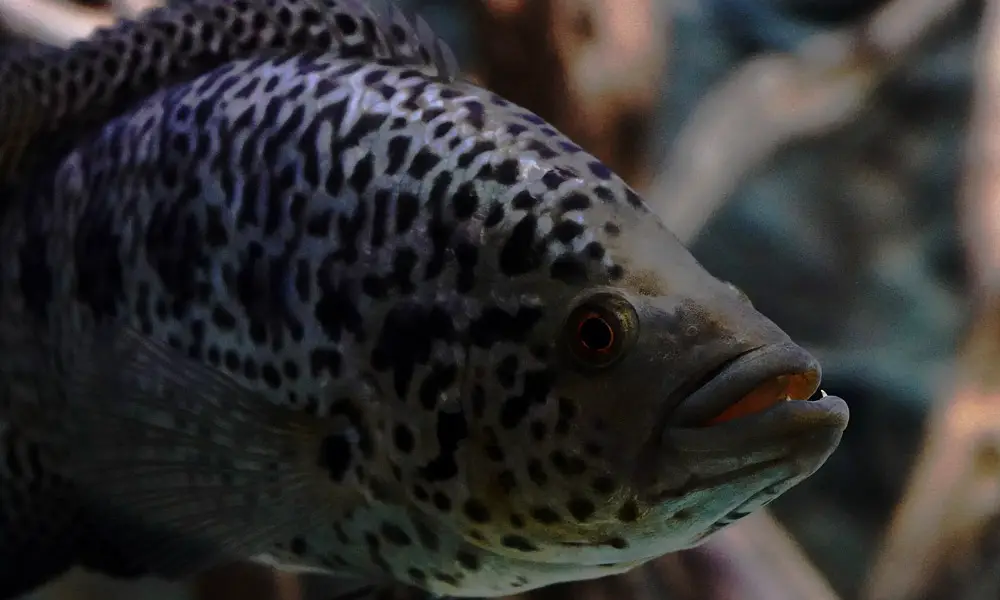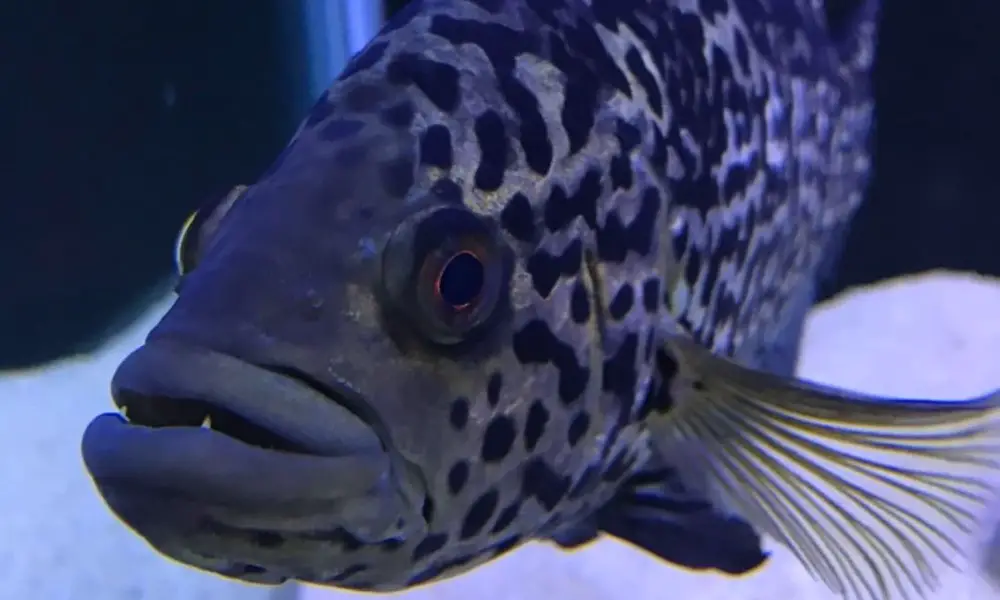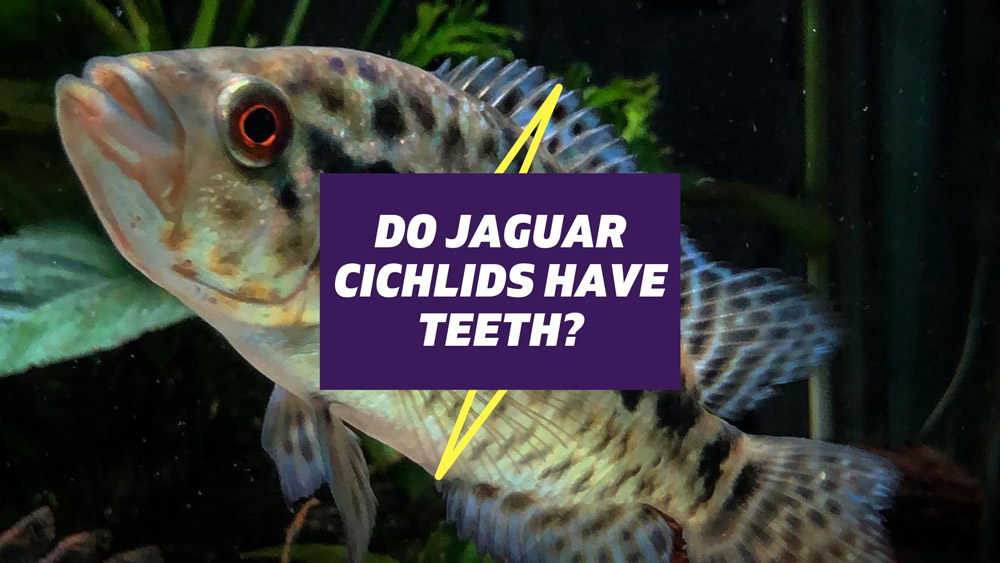The Jaguar cichlid (Parachromis managuensis) is one of the most popular species of Central American cichlid among the aquatic community. These fish tends to become more and more beautiful as they grow older.
Jaguar Cichlids are known for getting very large and being a feisty and highly aggressive species when mature. Keeping these large, aggressive predators can be a challenge for many aquarists.
This fish is not for everyone. If you’re thinking about getting one, there are definitely some things you’ll need to know. The most common question asked by aquarists is, “do Jaguar cichlids have teeth?”
So keep reading to find out everything about Jaguar cichlid teeth.
Do Jaguar Cichlids Have Teeth?

The answer is yes; Jaguar cichlids do have a well-developed pharyngeal set of jaws in their throats along with their regular sharp canine teeth. These extra sets of jaws are called “throat jaws,” which function as an extra food processor, and all cichlids have them, but the Jaguar cichlids are particularly large and sharp.
In fact, this second pair of jaws is an evolutionary adaptation to their diet; at least for Jaguar cichlids, they can adapt to other food sources within an individual’s lifetime.
Do Jaguar Cichlids Bite?
While their teeth might not be as big or as sharp as a dog’s, adult Jaguar Cichlids have been known to bite their owners during feeding or tank cleanings.
Their sharp teeth can cause a painful wound, so it’s definitely not something you want to experience. If you get bitten by your Jaguar cichlid, make sure to clean the wound immediately and seek medical attention if necessary.
Why Do Jaguar Cichlids Bite?

The first thing to remember is that Jaguar cichlids are natural predators, and they can become highly territorial and aggressive in some circumstances. There are many reasons that your fish might use their teeth to communicate:
They Are in Breeding Mode
When it is time to spawn, Jaguar cichlids become incredibly aggressive and can be quite dangerous. A spawning couple should always be kept in their own aquarium or in an aquarium that has been divided by a net or glass. If other fish are in the vicinity, the breeding pair will not hesitate to attack them, even if they are much larger than themselves.
They Are in Stress
Most aggressive behavior from Jaguar cichlid is on some level rooted in stress. If your jaguar cichlid is stressed, it may bite in an attempt to defend itself. It’s important to monitor your jaguar cichlid closely and remove any potential stressors from its environment.
The most common potential stressors are:
- Too small of an aquarium
- Incompatible tank mates
- Injure
- No hiding places or territories
- Harsh water conditions
- Bad water quality
They Are Hungry
If your jaguar cichlid is not getting enough to eat, it will become increasingly irritable and may start to bite.
These fish are not fussy eaters. They can protrude their extensively protrusible jaws 10% standard length in prey capture. They will readily accept most food substances offered, but their diet should be varied to provide the best nutrition.
Offer a variety of insects, including bloodworm, earthworm, mysis shrimp, crickets (for larger specimens), chopped meat, beef heart (offered sparingly due to its high-fat content), and prawns.
They Are Protecting Their Territory
Jaguar cichlids are known for being incredibly territorial, and they will often use their teeth to protect their territory from other fish. Ensure that you provide enough hiding places in your aquarium for your jaguar cichlids to escape any potential aggressors.
How To Avoid Getting Bitten by Jaguar Cichlids?
Remember that every fish is an individual with different needs and personalities. As an owner, it’s essential to be aware of your fish’s comfort level in various situations.
Try to remove them before they feel stressed or overstimulated, before your fish might feel a need to escalate to biting.
Let’s now take a look at the different ways to protect yourself from getting bitten by your Jaguar Cichlid.
Be Aware of Their Body Language
One of the best ways to avoid getting bitten by your jaguar cichlid is to be aware of their body language. Look for any signs of aggression, such as an upright body posture, erect fins, and mouth opening.
Stay Out of Their Territory
If you see your jaguar cichlid acting aggressively, it’s best to stay out of their territory until they calm down. This means keeping a safe distance and avoiding any sudden movements that might startle them.
Avoid Putting Your Hands in the Tank
It’s never a good idea to put your hands in the tank, as they may be mistaken for another fish or food. This is especially true if you have other fish in the tank that might be seen as a threat to your jaguar cichlid. It is always advisable to wear gloves when putting your hands in the tank.
Use a Net When Moving Them
If you need to move your jaguar cichlid, use a net. This will help to protect you from their sharp teeth.
Use a Temporary Divider When Cleaning the Tank
If you need to clean the tank, use a temporary divider to separate your jaguar cichlids to one side of the tank while providing a physical barrier for them to swim behind. This will help to keep them safe while you remove debris and clean the tank.
Will Jaguar Cichlids Bite Each Other?
Yes, Jaguar cichlids will bite each other, especially when breeding. The bonded pairs are not only aggressive toward other fish, but they may also nip at one another’s fins.
Therefore, you should set up a breeding aquarium where the smaller female can escape from being bitten by larger males or use a net with a hole limiting the male’s area.
Will Jaguar Cichlids Bite Other Fish?
Due to their large size and aggressive temperament, Jaguar Cichlids will bite other fish. They are the predators and will eat anything they can get their mouth around, including smaller fish and invertebrates.
The best practice is to keep mated pairs in their own aquarium. If you keep other fish in the same tank, make sure that they are large Central and South American cichlids and provide plenty of hiding places.
Don’t keep a breeding pair with other catfish or plecostomus as they will eat the eggs or fry.
Conclusion
So, there you have it! Everything you need to know about jaguar cichlids teeth and how to avoid getting bitten by them. By following these simple tips, you can ensure that both you and your jaguar cichlid stay safe and healthy.
If we missed something or there’s anything you think we should add, we’re more than happy to hear from you in the comments below.





